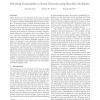158 search results - page 2 / 32 » Community Learning by Graph Approximation |
ICML
2007
IEEE
14 years 6 months ago
2007
IEEE
Basis functions derived from an undirected graph connecting nearby samples from a Markov decision process (MDP) have proven useful for approximating value functions. The success o...
ICCBR
2007
Springer
13 years 12 months ago
2007
Springer
We identify two fundamental points of utilizing CBR for an adaptive agent that tries to learn on the basis of trial and error without a model of its environment. The first link co...
COMSWARE
2008
IEEE
13 years 7 months ago
2008
IEEE
Social networks refer to structures made of nodes that represent people or other entities embedded in a social context, and whose edges represent interaction between entities. Typi...
SDM
2011
SIAM
12 years 8 months ago
2011
SIAM
In this paper we present a fast and accurate procedure called clustered low rank matrix approximation for massive graphs. The procedure involves a fast clustering of the graph and...
SDM
2009
SIAM
14 years 3 months ago
2009
SIAM
Many datasets can be described in the form of graphs or networks where nodes in the graph represent entities and edges represent relationships between pairs of entities. A common ...

